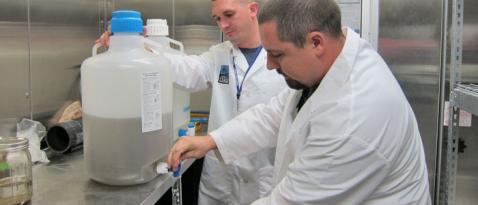Interning for a greener future at Center for Urban Waters
Talk of stormwater and storm drains sounds so gray, so grimy, so boring. Yet mention stormwater to UW Tacoma’s Brian Hite, Jacob Moore and John Pelerine, and get set for an animated discussion.
This Section's arrow_downward Theme Info Is:
- Background Image: ""
- Theme: "light-theme"
- Header Style: "purple_dominant"
- Card Height Setting: "consistent_row_height"
- Section Parallax: ""
- Section Parallax Height: ""

Talk of storm water and storm drains sounds so gray, so grimy, so boring. Yet mention storm water to UW Tacoma’s Brian Hite, Jacob Moore and John Pelerine, and get set for an animated discussion on rain gardens, pollution’s deadly effect on baby salmon, and research that may someday lead to cleaner waters in Puget Sound.
The three began working as paid interns for UW Tacoma at the Center for Urban Waters last July, studying which soil mixes do the best job of capturing harmful nutrients and other chemicals found in storm water. Moore, '11, and Pelerine, '11, each graduated with a bachelor’s degree in environmental studies, but Hite, a senior in environmental science, is continuing to analyze data they collected.
Their internships were among eight supported by the UW Puget Sound Institute, which is funded through a grant from the U.S. Environmental Protection Agency to the Center for Urban Waters.
Other interns:
- Measured contamination levels of sediments in South Sound waters.
- Demonstrated how to use Microsoft Access database software to analyze massive quantities of scientific data.
- Examined whether the water and power systems for the 2-year-old Center for Urban Waters building operate as efficiently as projected under green design standards.
- Measured air pollution levels on Tacoma’s industrial Thea Foss Waterway.
“At the cutting edge of research”
The projects are prime examples of the ongoing opportunities for undergraduate and graduate research at the center.
“Urban Waters was created to provide UW Tacoma students the opportunity to conduct real-world research alongside experienced scientists and engineers,” said Joel Baker, the center’s science director. “Our fantastic first group of summer interns has set the bar high, and I look forward to expanding this program each summer.”
At the center, research is more than just a theoretical exercise. Findings and data contribute to the pursuit of solutions for real-life environmental problems.
Center scientists collaborate and share information with researchers and staff from the City of Tacoma, Washington State University and other entities working to restore and protect ecosystems.
Chris Burke, a senior environmental specialist with the city, welcomed the opportunity to listen to the interns’ research presentations this fall.
"Students are often at the cutting edge of research.... They have new ideas, and they tend to be very dedicated and enthusiastic.” Burke said. “So what better partner can you link up with?”
Stormwater pollutes
Burke was particularly interested in the project by Hite, Moore and Pelerine.
The interns collected data as part of a long-term study by WSU scientists in Puyallup focusing on stormwater, a key source of pollution in Puget Sound.
Stormwater begins as rain, picks up gas, oil and other chemicals as it falls on roadways, then spills down storm drains and shoots untreated into the Sound, endangering aquatic life.
One way to clean stormwater is through rain gardens — native shrubs and perennials planted into small depressions that catch the runoff from streets, driveways and roofs. Rain gardens capture contaminants from the water as it slowly filters through the vegetation and soil, down into the groundwater aquifer.
Yet the gardens’ cleansing effect can diminish over time, and varies with each setting’s mix of soils and materials.
Cleansing dirty water
Enter the interns from the Center for Urban Waters.
To determine which soil mixes best remove contaminants, the interns prepared various combinations of sand, compost, charcoal, the City of Tacoma’s “Tagro” biosolids soil, and chemical residues used to treat water. They made their own stormwater from rainwater collected in rain barrels and sludge scooped from city storm drainpipes.
They placed the soil mixes into upright segments of PVC pipe, called columns, in the center’s lab. Then, explained Hite, holding a beaker filled with stormwater, “We pour this dirty water through the top of our columns to see if the columns clean the water up, and how well they clean the water up.”
The interns found “water treatment residuals” — the aluminum and iron salts left over at the water treatment plant — was the most effective medium they tested for eliminating phosphorus, a nutrient that causes suffocating algae blooms and ruins water quality.
Meanwhile, sand was the best remover of metals, such as copper, zinc, aluminum, cadmium, lead and nickel, from storm water.
Copper hurts young Chinook
Metals, the interns noted, can imperil the survival of fish. Previous studies have found that when predators attack young Chinook salmon, the fish release a chemical that acts as an alarm, Pelerine said. Juvenile salmon smell the chemical and sink to the bottom of the water to avoid the predator.
“When they’re exposed to copper, it kills the olfactory senses in fish, so they don’t have that predatory reaction,” said Pelerine, 31. “Even low levels of copper can affect their sensory abilities.”
Copper enters Puget Sound and its tributaries from many sources, including being released as a powder onto roads when drivers apply the brakes, Pelerine said.
“A future with clean water”
The research was the perfect training opportunity for Pelerine, whose schooling at UW Tacoma was part of his military service. The Army lieutenant hopes to be assigned someday as an environmental scientist in the Medical Service Corps.
“This helps me be competitive by having an environmental studies degree and by having done an internship in stormwater research,” said Pelerine, who is stationed at Joint Base Lewis-McChord.
Meanwhile, Hite has found his true calling since entering UW Tacoma. The Puyallup father of two once worked as a sheet metal mechanic and roofer, until a serious hand injury ended his construction career. He attended Pierce College for two years, then transferred to the Tacoma university.
“It completely changed my life,” said Hite, 31.
After completing his bachelor’s degree in environmental science, Hite plans to pursue a master’s degree in environmental engineering at UW Seattle. His goal is to become a stormwater scientist.
“I’d like to be helping to design the rain gardens of the future,” Hite said. “I have kids and I want them to have a future with clean water.”
Recent news
Main Content
Gathering Strength
News Tags on this arrow_upward Story:
- None
Main Content
UW Tacoma Enrollment up 4% for Autumn 2024
News Tags on this arrow_upward Story:
- None
Main Content
Celebrating First Gen
News Tags on this arrow_upward Story:
- None



